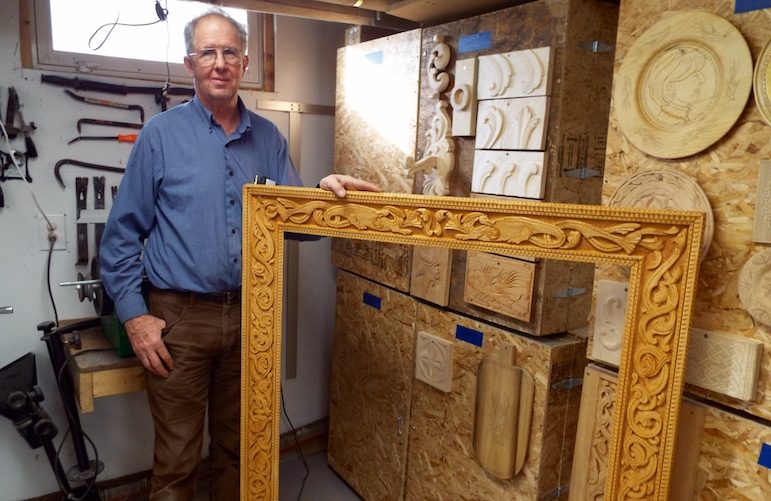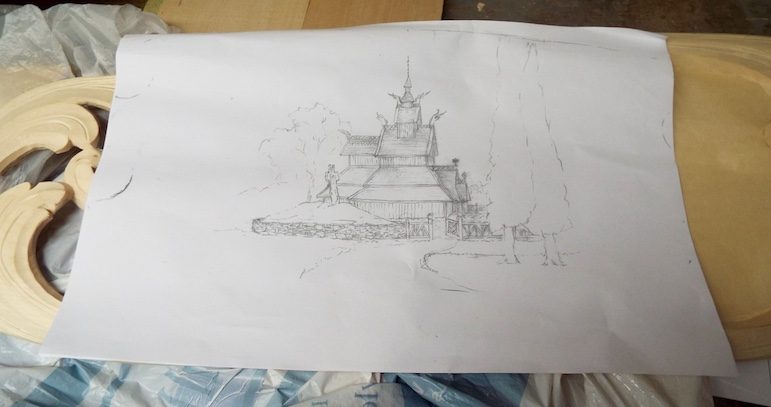Billings native throws himself into art of Norwegian carving

Greg Aldrich shows the custom-made picture frame that he will be submitting to a craftman's contest this summer.

A close-up shows a dragon Aldrich carved on the picture frame.
Aldrich was working on this carved bowl, which comes with plastic inserts so you don't have to wash the wooden vessel.
A tine box with kolrosing details.

A drawing of a stave church.
Walking down the steps to Greg Aldrich’s basement workshop, one enters a kind of wonderland filled with ornate and elegant Norwegian woodcarvings and countless tools. The air is scented from the piles of basswood ready to be carved into beautiful pieces.
A group of woodcarvers studying under Aldrich gather around their works in progress—small, decorative, oval containers known in Norway as tine (pronounced tee-nah) boxes. Aldrich sits quietly in a chair, watching their progress intently. Aldrich, born and raised in Billings, started practicing the craft only 10 years ago.
Aldrich said the lumberyard he used to own created works for many years for Playhouse Parades, a fundraiser for at-risk kids, which involved auctioning off custom-made playhouses. One year, Aldrich thought of making a playhouse based on stabburs, Norwegian farm buildings used for storing meat and other products.
“We went to the Sons of Norway and asked them if they wanted to participate with us making the playhouse, which we donated out to the mall,” he said.
The Sons of Norway did, and one of them, Ray Albert, got Aldrich started on Norwegian carvings.
“It just kind of came about,” Aldrich said. “As soon as I’d have one design, I’d ask my teacher to do another for me for another project. Each one you’d do would be harder and more intertwining—more things just to push you. So it’s been fun.”

Desiree Kling
This is one of two door panels Aldrich carved in the acanthus style.
Aldrich’s heritage is English, but his wife, Thora, is half Norwegian, and both are now active members of the Sons of Norway. They have also visited Norway with other woodcarvers several times in the past few years to study woodcarving in more detail.
“When we went over there they had the museums lined up and they would tell them what we wanted to see,” Aldrich said. “Before we got there the curators would go down into their permanent collections and get the best crème de la crème from Norway and set them out in separate rooms that we could go into that the public wasn’t allowed. We could handle them, look at them, take pictures, sketch—do whatever we wanted. We were doing a couple of museums a day for 30 days in a row. We were moving all over Norway.”
Aldrich said that Norwegian woodcarving originated in rural Norway, and was most often done in the winter. The carvers used a variety of techniques, including long-tool carving, kolrosing and chip carving to make products for their homes.
Long-tool carving refers to carving with elongated knives; kolrosing is the art of decorating the wood by slicing thin lines into the wood and filling them in with a dark substance, creating a tattoo look; and chip carving involves using knives and tools to chip away small pieces of wood to create patterns.
These techniques were also applied to churches, along with acanthus carvings. These pieces use the acanthus plant as a model for carving beautiful scrolling leaves and designs into the wood. The oldest churches often had dragon carvings mixed with depictions of their pre-Christian gods. Later, stave churches were built that merged the images of the dragons with images of crosses. Aldrich uses all these techniques in his carvings and practices his skills with the best instructors from around the country.
“I go to Vesterheim museum for classes in Decorah, Iowa, and the teacher, Hans Sandom, has things all over the world,” Aldrich said. “When the United States government invited the king and queen of Norway to our country, the gift box that was carved for them was done by Hans.”
Aldrich has also taken classes from Phil Odden and his wife, Else, who have worked on movie sets.
“They’re the ones who have a flatter style, a little different style, and they’re out of Wisconsin,” Aldrich said. “I’ve taken classes from them and they’re the ones that have done all the carving and all the furniture scenes from ‘Frozen’ for Disney. All their work is on display at Disneyland.”
Aldrich’s carvings, however, are purely functional. A former architect and lumberyard owner, Aldrich is retired now, and he has no interest in making money off his work. For this woodcarver, the hobby is purely for enjoyment.
“I don’t carve anything that I don’t use,” he said. Asked if he ever sells his work, he said, “Absolutely not. How could you sell something that you have two months worth of work into? I don’t mind if my wife wants me to make something for somebody, though. She’ll give it to them and that’s fine.”
Aldrich also enjoys teaching others how to carve. He has been holding classes in the basement shop of his West End home in Billings for about six years.
“It’s one of the fun things with the Sons of Norway group that we do,” Aldrich explained. “There are a lot of nice people in there, and they’re all everyday people who like to come in and figure out how to do different things. You don’t have to be Norwegian to be in it either. Obviously, because I’m not.”
He holds his classes whenever he’s in Billings and not traveling to learn new carving techniques or exploring the culture in Norway. The classes meet three or four times a year, or, as he jokes, “However many times they can twist my arm.”

Desiree Kling
Aldrich made all these knives. The leather is from Italy, the blades are from Norway, the wood is from Finland, and the bone is from Norwegian reindeer antlers.
At the moment, the class is working on Norwegian tine boxes that are large enough to store many items but small enough to sit out on a counter. Aldrich has had members of the Helena Sons of Norway group come down to his shop to teach his students chip carving.
“On these tine boxes,” he said, “they’ll have to chip carve all the lids, and then they’ll kolrose all the sides.”
Aldrich has many of his own pieces around his shop, including a magnificent picture frame decorated with intricate dragons, acanthus-style door panels, and works made by kolrosing. He intends to submit his picture frame and door to the Vesterheim contest for craftsmen this summer. His method starts with the purchase of high-quality carving wood and making use of a variety of tools.
“For carving, the easiest to work with is basswood that has not been kiln dried,” he said. “It’s got to be air-dried. I generally get it from Wisconsin, on the Canadian border. When it’s air-dried it’s not chippy when you carve it.”
His carving tools are all sharpened to 25 degrees—sharper than a razor blade—and have been obtained from all over.
“When (Ray) Albert passed away I bought all of his tools,” he said. “Then, as I go to carving classes, I always try to pick up two or three extra. When I was in Norway I picked up four or five. I also make my own tools. All the ones with the dark walnut are made by me.”
Despite his obvious skills and his teaching, Aldrich is humble about his work. His friend Donald Jore called him a master woodcarver, but Aldrich doesn’t think of himself in those terms. He said he just wants to keep on learning and challenging himself to be better.
“I look back at my old ones and they’re not as good as my new ones,” Aldrich said. “My favorite one is generally the last one I do. I keep trying to get better.”
Comments
comments










Pingback: Prairie Lights: Plenty to be thankful for in 2017 | Last Best News